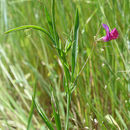Distribution in Egypt
provided by Bibliotheca Alexandrina LifeDesk
Nile region, oases and Mediterranean region.
- author
- BA Cultnat
- provider
- Bibliotheca Alexandrina
Global Distribution
provided by Bibliotheca Alexandrina LifeDesk
North Africa, south and central Europe, west Asia.
- author
- BA Cultnat
- provider
- Bibliotheca Alexandrina
Associations
provided by BioImages, the virtual fieldguide, UK
In Great Britain and/or Ireland:
Foodplant / parasite
conidial anamorph of Erysiphe trifolii parasitises live Lathyrus hirsutus
Description
provided by eFloras
Scrambling annual, sparsely pubescent. Stem winged. Leaf pinnately compound, leaflets 2, 3.0-6.0 cm long, 3-11 mm broad, linear or oblong; stipules 10-18 mm long, linear, semisagittate, rachis ending in 3-sect or pinnately branched tendrils. Raceme 1-3-flowered, peduncle much longer than leaf. Calyx 4.5-5.5 mm long, teeth subequal, as long as or slightly longer than the tube. Corolla red or bluish purple, 10-14 mm long. Fruit 2-5 cm long, 5-8 mm broad, oblong-linear, pubescent, tuberculate, 5-10-seeded.
- license
- cc-by-nc-sa-3.0
- copyright
- Missouri Botanical Garden, 4344 Shaw Boulevard, St. Louis, MO, 63110 USA
Distribution
provided by eFloras
Distribution: Kashmir; Russia; N. Iran; Lebanon; N.Africa; S. & C. Europe.
- license
- cc-by-nc-sa-3.0
- copyright
- Missouri Botanical Garden, 4344 Shaw Boulevard, St. Louis, MO, 63110 USA
Physical Description
provided by USDA PLANTS text
Annual, Herbs, Taproot present, Nodules present, Stems erect or ascending, Stems or branches arching, spreading or decumbent, Stems prostrate, trailing, or mat forming, Stems less than 1 m tall, Climbing by tendrils, Stems solid, Stems or young twigs glabrous or sparsely g labrate, Stems winged or with decurrent stipules, Leaves alternate, Leaves petiolate, Stipules conspicuous, Stipules green, triangulate to lanceolate or foliaceous, Stipules persistent, Stipules free, Leaves compound, Leaves even pinnate, Leaf or leaflet margins entire, Leaflets opposite, Leaflets 2, Leaves glabrous or nearly so, Flowers in axillary clusters or few-floweredracemes, 2-6 flowers, Inflorescence axillary, Bracts very small, absent or caducous, Flowers zygomorphic, Calyx 5-lobed, Calyx hairy, Petals separate, Corolla papilionaceous, Petals clawed, Petals pinkish to rose, Petals blue, lavander to purple, or violet, Banner petal ovoid or obovate, Banner petal suborbicular, broadly rounded, Wing petals narrow, oblanceolate to oblong, Wing petals auriculate, Wing tips obtuse or rounded, Keel tips obtuse or rounded, not beaked, Stamens 9-10, Stamens diadelphous, 9 united, 1 free, Filaments glabrous, Style flattened, Style hairy, Style hairy on one side only, Style per sistent in fruit, Fruit a legume, Fruit unilocular, Fruit freely dehiscent, Fruit elongate, straight, Fruit exserted from calyx, Valves twisting or coiling after dehiscence, Fruit hairy, Fruit 3-10 seeded, Seeds ovoid to rounded in outline, Seed surface wrinkled or rugose, Seeds olive, brown, or black.
Lathyrus hirsutus: Brief Summary
provided by wikipedia EN
Lathyrus hirsutus is a species of wild pea known by several common names, including Caley pea, singletary pea, hairy vetchling, and Austrian winter pea. It is native to Europe, North Africa, and much of Asia, and it is known from other continents, including North America, as an introduced species. This is an annual herb producing a winged stem and leaves each made up of two leaflike leaflets with a branching, coiled tendril. The inflorescence holds one or two pink, blue, or bicolored pea flowers each 1 to 1.5 centimeters wide. The fruit is a dehiscent legume pod covered in hairs with each hair growing from a minute bulbous base. The rest of the plant is generally hairless.

Lathyrus hirsutus sown September 2014 in the UBC Botanical Garden.
- license
- cc-by-sa-3.0
- copyright
- Wikipedia authors and editors


 Lathyrus hirsutus sown September 2014 in the UBC Botanical Garden.
Lathyrus hirsutus sown September 2014 in the UBC Botanical Garden.